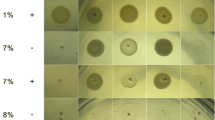Abstract
The high osmolarity glycerol (HOG) signaling pathway is crucial for yeast to cope with high osmolarity. Here, we showed that Saccharomyces cerevisiae rice wine isolates exhibited higher tolerance to osmotic stress, which was associated with the evolution of HOG pathway genes. Phylogenetic analysis of HOG genes revealed that Chinese rice wine strains were closely related to sake strains, indicating a common origin of rice wine strains. The DNA sequence diversity analysis showed that higher levels of polymorphism tended to accumulate on the osmosensor genes (MSB2 and SLN1), suggesting that most changes in a signaling transduction pathway were concentrated in the receptors. Moreover, the rapid evolution of osmosensors (Sln1/Msb2) and transcription factor (Msn4) might experience positive selection. Our results imply that the evolution of HOG pathway genes in S. cerevisiae rice wine strains is associated with their adaptation to high osmotic environments.



Similar content being viewed by others
References
Aa E, Townsend JP, Adams RI, Nielsen KM, Taylor JW (2006) Population structure and gene evolution in Saccharomyces cerevisiae. FEMS Yeast Res 6(5):702–715
de Nadal E, Real FX, Posas F (2007) Mucins, osmosensors in eukaryotic cells? Trends Cell Biol 17(12):571–574
Dhar R, Sagesser R, Weikert C, Yuan J, Wagner A (2011) Adaptation of Saccharomyces cerevisiae to saline stress through laboratory evolution. J Evol Biol 24(5):1135–1153
Diezmann S, Dietrich FS (2009) Saccharomyces cerevisiae: population divergence and resistance to oxidative stress in clinical, domesticated and wild isolates. PLoS ONE 4(4):e5317
Erasmus DJ, van Vuuren HJJ (2009) Genetic basis for osmosensitivity and genetic instability of the wine yeast Saccharomyces cerevisiae VIN7. Am J Enol Vitic 60(2):145–154
Estruch F (2000) Stress-controlled transcription factors, stress-induced genes and stress tolerance in budding yeast. FEMS Microbiol Rev 24(4):469–486
Fay JC, Benavides JA (2005) Evidence for domesticated and wild populations of Saccharomyces cerevisiae. PLoS Genet 1(1):66–71
Hall T (1999) BioEdit: a user-friendly biological sequence alignment editor and analysis program for Windows 95/98/NT. Nucleic Acids Symposium Series: 95-98
Jovelin R, Dunham JP, Sung FS, Phillips PC (2009) High nucleotide divergence in developmental regulatory genes contrasts with the structural elements of olfactory pathways in caenorhabditis. Genetics 181(4):1387–1397
Kvitek DJ, Will JL, Gasch AP (2008) Variations in stress sensitivity and genomic expression in diverse S. cerevisiae isolates. PLoS Genet 4(10):e1000223
Larkin MA, Blackshields G, Brown NP, Chenna R, McGettigan PA, McWilliam H, Valentin F, Wallace IM, Wilm A, Lopez R, Gibson TJ, Higgins DG (2007) Clustal W and Clustal X version 2.0. Bioinformatics 23(21):2947–2948
Legras JL, Merdinoglu D, Cornuet JM, Karst F (2007) Bread, beer and wine: Saccharomyces cerevisiae diversity reflects human history. Mol Ecol 16(10):2091–2102
Li YD, Liang H, Gu Z, Lin Z, Guan W, Zhou L, Li YQ, Li WH (2009) Detecting positive selection in the budding yeast genome. J Evol Biol 22(12):2430–2437
Librado P, Rozas J (2009) DnaSP v5: a software for comprehensive analysis of DNA polymorphism data. Bioinformatics 25(11):1451–1452
Liti G, Carter DM, Moses AM, Warringer J, Parts L, James SA, Davey RP, Roberts IN, Burt A, Koufopanou V, Tsai IJ, Bergman CM, Barton BH, Jones M, Goodhead I, Sims S, Smith F, Blomberg A, Durbin R, Louis J (2009) Population genomics of domestic and wild yeasts. Nature 458(7236):337–341
McDonald JH, Kreitman M (1991) Adaptive protein evolution at the Adh locus in Drosophila. Nature 351(6328):652–654
McGovern PE, Zhang JZ, Tang JG, Zhang ZQ, Hall GR, Moreau RA, Nunez A, Butrym ED, Richards MP, Wang CS, Cheng GS, Zhao ZJ, Wang CS (2004) Fermented beverages of pre- and proto-historic China. Proc Natl Acad Sci USA 101(51):17593–17598
Mortimer RK (2000) Evolution and variation of the yeast (Saccharomyces) genome. Genome Res 10(4):403–409
Muzzey D, Gomez-Uribe CA, Mettetal JT, van Oudenaarden A (2009) A systems-level analysis of perfect adaptation in yeast osmoregulation. Cell 138(1):160–171
Nikolaou E, Agrafioti I, Stumpf M, Quinn J, Stansfield I, Brown AJ (2009) Phylogenetic diversity of stress signalling pathways in fungi. BMC Evol Biol 9:44
O’Rourke S, Herskowitz I, O’Shea E (2002) Yeast go the whole HOG for the hyperosmotic response. Trends Genet 18(8):405–412
Querol A, Fernandez-Espinar MT, del Olmo M, Barrio E (2003) Adaptive evolution of wine yeast. Int J Food Microbiol 86(1–2):3–10
Schacherer J, Shapiro JA, Ruderfer DM, Kruglyak L (2009) Comprehensive polymorphism survey elucidates population structure of Saccharomyces cerevisiae. Nature 458(7236):342–345
Tamura K, Dudley J, Nei M, Kumar S (2007) Mega 4: molecular evolutionary genetics analysis (MEGA) software version 4.0. Mol Biol Evol 24(8):1596–1599
Wu X, Chi X, Wang P, Zheng D, Ding R, Li Y (2010) The evolutionary rate variation among genes of HOG-signaling pathway in yeast genomes. Biol Direct 5:46
Yang Z (2007) PAML 4: phylogenetic analysis by maximum likelihood. Mol Biol Evol 24(8):1586–1591
Zheng DQ, Wu XC, Tao XL, Wang PM, Li P, Chi XQ, Li YD, Yan QF, Zhao YH (2010) Screening and construction of Saccharomyces cerevisiae strains with improved multi-tolerance and bioethanol fermentation performance. Bioresour Technol 102(3):3020–3027
Acknowledgments
We thank Dr. Xiaoqin Chi (Zhejiang University) for her technical help during the course of the project. This work was supported by grants from the National Natural Science Foundation of China (No. 31101339) to Y. Li and the Zhejiang Provincial Natural Science Foundation (No. Y3100609) to X. Liang.
Author information
Authors and Affiliations
Corresponding authors
Electronic Supplementary Material
Below is the link to the electronic supplementary material.
Rights and permissions
About this article
Cite this article
Li, Y., Chen, W., Shi, Y. et al. Molecular Cloning and Evolutionary Analysis of the HOG-Signaling Pathway Genes from Saccharomyces cerevisiae Rice Wine Isolates. Biochem Genet 51, 296–305 (2013). https://doi.org/10.1007/s10528-012-9563-8
Received:
Accepted:
Published:
Issue Date:
DOI: https://doi.org/10.1007/s10528-012-9563-8




